Aishwarya Sunaad, Ananay Agarwal and Priyamvada Trivedi
20 March 2021 | 3 min read
In this piece we look towards Assam, where the 2021 assembly elections are scheduled to be held across three phases on March 27, April 1 and April 6 respectively. Our focus in this article is to look at newcomers––those contesting assembly elections for the first time––and their performance. So how do we do it? We use TCPD’s Incumbency Visualization tool to look at newcomers and how they performed across the last few elections at an all Assam level. We then dis-aggregate the numbers by party to see if there are any interesting variations.
First time contestants
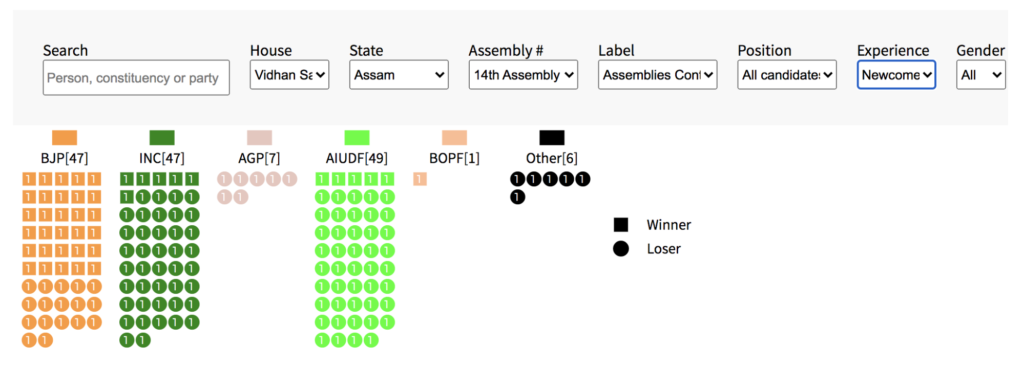
We can get the exact count by looking more closely at the data itself by clicking on “Browse/download detailed results” at the bottom of the screen. The user is then directed to TCPD’s data collation tool, Lok Dhaba, where they can view and download the complete election results for the 2016 Assam Vidhan Sabha elections.
Once downloaded, we can view the Newcomers in 2016 by choosing the following filters :
- Year is selected to be 2016
- Poll_No is selected to be 0 (1 means a bye-poll)
- Contested is selected to be 1 (which means contesting for the first time, a value of 2 means contesting for the second time, a value of 3 means contesting for the third time and so on)
Table 1 summarizes this information for the last 5 elections. However, it is important to note that looking at absolute numbers does not give us a sense of how to accurately compare newcomers across different assemblies. This is because the total number of candidates contesting, irrespective of elections contested, also varies with the assemblies. Hence, to compare across assemblies we look at the percentage of newcomers in a given year in relation to the total number of candidates.
To get the total number of contestants in 2016, for example, the filters need to be set to the following:
- Year= 2016
- Poll_No = 0
- Party, deselect “NOTA”,as we are interested in looking only at individuals.
Based on such a selection we get a total of 1064 contestants in the 2016 assembly elections in Assam. Table 1 presents the percentages for the last 5 elections and Figure 2 presents this information in a graphical form.
Table 1: Number of newcomers and their share among all contestants
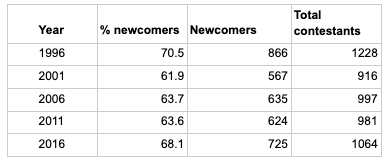
Figure 2: Newcomers in the last five Assam Vidhan Sabha elections by percentage
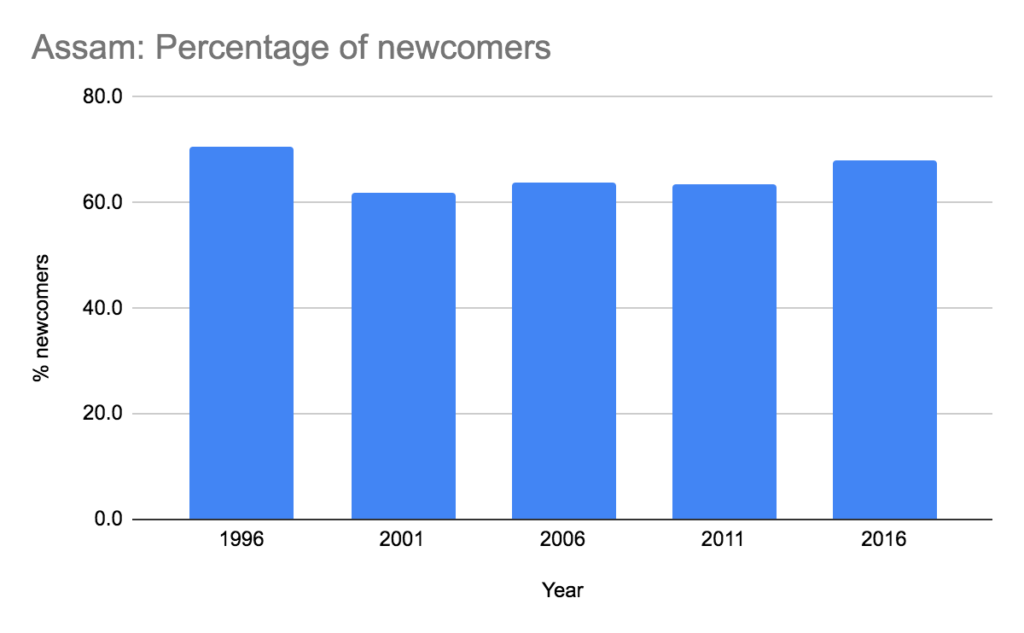
From Figure 2, we see that the share of first time contestants has varied between 62% and 70% in the last five assemblies.
First time independent contestants
It is also worthwhile to see how many newcomers were Independent candidates. Figure 3 shows us the percentage of newcomers who contested as Independent candidates.
Figure 3: Percentage of newcomers who contested as Independent candidates
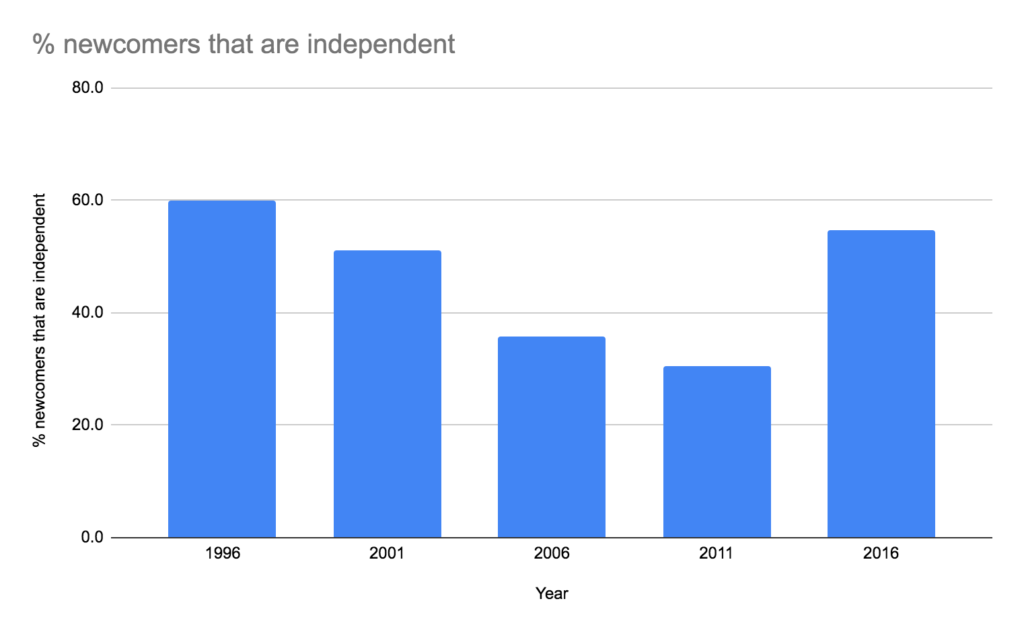
Based on the data from the last 5 elections, from Figure 3, we observe then, that the share of Independent newcomers was on a decrease from 1996 to 2011, but there was a substantial jump in their share in 2016.
Do newcomers always win?
So far, we have had a look at the trends in the number of newcomers contesting in elections in Assam over the years. It is imperative, though, to also look at how they performed in these elections as well. It will enable us to gauge how receptive voters are to newcomers and also allow us to comment on the possible reasons for the success or failure of first-time candidates
Table 2 summarizes the total number of newcomers i.e., those contesting elections for the first time, and their performance for 5 parties – Bharatiya Janata Party (BJP), Indian National Congress (INC), Asom Gana Parishad (AGP), All India United Democratic Front (AIUDF) and Bodoland Peoples Front (BOPF).
Table 2: Party-wise performance of newcomers
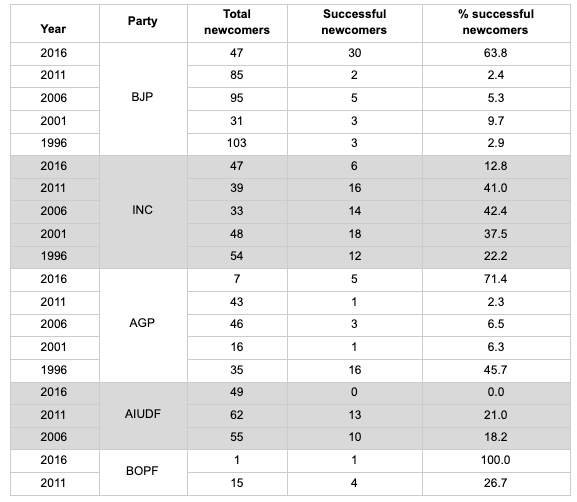
While the BJP and INC are national parties, AGP, AIUDF and BOPF are state parties. Please note that there is no data for AIUDF for 1996 and 2006 as the party (formerly called the Assam United Democratic Front) was formed in 2005 and it contested elections for the first time in 2006. Similarly, the BOPF contested elections for the first time in 2011. Figure 4 presents this information in a visual format.
Figure 4: Performance of newcomers (those contesting elections for the first time) by political party for the last 5 years.
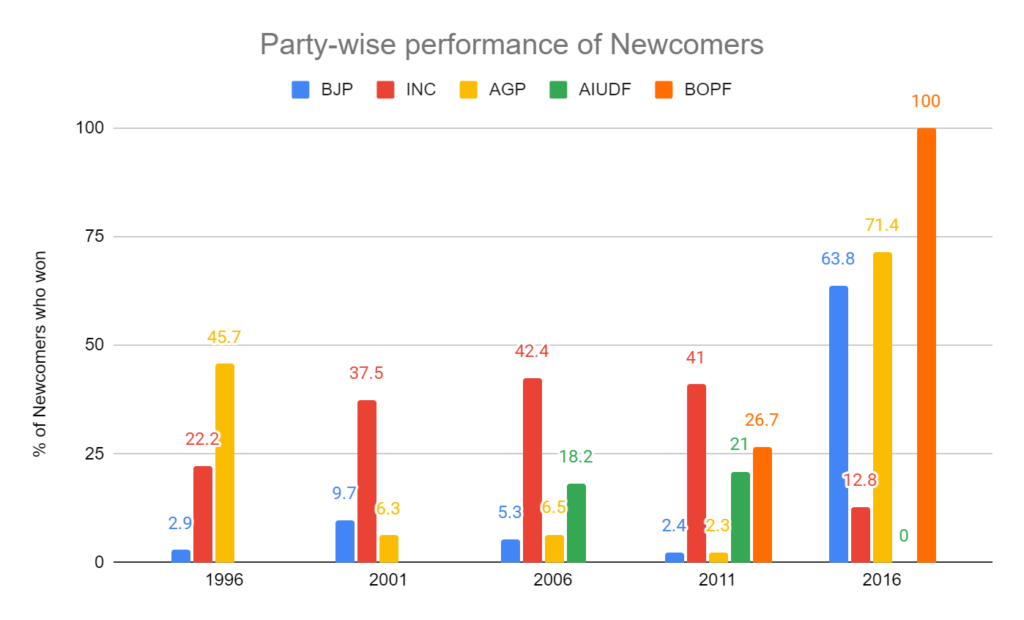
Performance of first-time contestants across national parties and state parties
From Table 2 and Figure 4, we observe that across the last 5 elections, for the national parties – INC and BJP – the performance of first time contestants on an INC ticket has deteriorated while the performance of those contesting on BJP has greatly improved. Both INC and BJP fielded 47 newcomers in 2016, however the success rate for INC was 12.8% (6 won) and the BJP was 63.8% (30 won), a significant difference.
Looking at the performance of the state parties, such as AGP, we observe that while about 71% of the newcomers were successful, in terms of absolute numbers there was a dip in the number of newcomers to begin with. For instance, from Table 2, we see that in 1996 the AGP fielded 35 newcomers, in 2001 it fielded 16, in 2006 there were 46, in 2011 there were 43, and in 2016 the number was only 7. At this point we also must remember that the BJP and AGP were part of the same alliance in 2016 and perhaps the decision to field a lower than usual number of newcomers by the AGP could have been a strategic and joint decision.
We must also note that both the AIUDF and the BOPF are relatively new state parties. While the success rate of newcomers fielded by AIUDF was better than AGP in the 2006 (18.2% vs. 6.5%) and 2011 (21% vs. 2.3%) assembly elections, AIUDF had a 0% success rate in 2016. Figure 4 shows that BOPF actually had a better success rate in 2011 and 2016 as compared to AGP and AIUDF, however the number of newcomers fielded has been on the lower side for both election years.
The making of new waves
While it is crucial to engage in depth with the prevailing social and political dynamics in order to fully understand the place of newcomers in Assam politics as we go ahead, we can analyse the data above to gain a few insights into the political landscape of the state.
Looking only at the data, the performance of newcomers, one can argue, can be contingent on the candidate’s party affiliation on a macro scale, and on the candidate’s caste, religion or community on a more local level. For example, we see that newcomers from the BJP did very well in 2016, while newcomers from the INC did not do so well. There seems to be a general improvement in the performance of newcomers from the state parties as well, though this also has to do with the fact that fewer newcomers have been contesting from these parties, pushing the percentage upwards. In general, the percentage of newcomers contesting in the Assam assembly elections has remained relatively steady between 62 – 70%. The rise in the number of Independent and BJP newcomers getting elected in 2016 seems to suggest that 2016 marked a change in the political landscape of the state. This hypothesis gains more credence from the fact that the INC, that has regularly had 14-18 newcomers elected for the past 3 assemblies, only had 6 newcomers that managed to win in 2016. However, we need to continue observing and adding to this dataset to understand whether this shift in the political landscape is robust.
We encourage you to explore the data and use the incumbency tool. It is the product of a lot of time, hard work and love put in by TCPD staff members and our fabulous interns. If you spot errors and/or have any feedback, please get in touch with us at tcpd-contact@ashoka.edu.in
References
“TCPD Individual Incumbency Dataset, 1962-current”. Trivedi Centre for Political Data, Ashoka University.
Ananay Agarwal, Prashasti Agarwal, Payoja Ahluwalia, Saloni Bhogale, Jenish Raj Bajracharya, Sudheendra Hangal, Samridhi Hooda, Mohit Kumar, Visvesha Murthi, Basim U Nissa, Vaibhav Parik, Ayaan Sagar, Niharika Tiwari and Gilles Verniers. 2021. “TCPD Individual Incumbency Dataset, 1962-current Codebook 1.0″, Trivedi Centre for Political Data, Ashoka University.
ECI. “Assam 2006.” Election Commission of India, 20 Aug. 2018, eci.gov.in/files/file/4009-assam-2006/.
ECI. “Assam 2011.” Election Commission of India, 20 Aug. 2018, eci.gov.in/files/file/4010-assam-2011/.
ECI. “Assam General Legislative Election 2016.” Election Commission of India, 20 Aug. 2018, eci.gov.in/files/file/4017-assam-general-legislative-election-2016/.
Staff, Scroll. “Asom Gana Parishad Will Fight 2016 Assam Elections with BJP.” Scroll.in, scroll.in/latest/804501/asom-gana-parishad-will-fight-2016-assam-elections-with-bjp.

